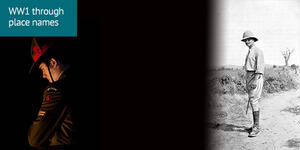
The New Zealand Dawn Service, Le Quesnoy Communal Cemetery Extension - Lieutenant-General William Birdwood, commander of the Australian and New Zealand Army Corps. Pictured near Hill 60 at Anzac, Gallipoli, on 6 October 1915.
At the height of the First World War, the Ministry of Lands drew up a scheme to replace New Zealand feature names that were considered too ‘alien’, i.e. German or Austro-Hungarian, with others deemed more appropriately ‘British’. Along with a number of statesmen, explorers, and admirals, one of the substitute names mooted was ‘Birdwood’. However, it was quickly discovered that ‘Birdwood’ had already been allocated to a mountain range at the head of the Wilberforce River.
Lieutenant-General William Birdwood was the first commander of the Australian and New Zealand Army Corps (ANZAC). He led that unit during the landings at Anzac Cove on 25 April 1915, as part of an attempt to force the straits of the Dardanelles and eventually capture Constantinople. Eight months later, it fell to Birdwood to coordinate the Allied evacuation of Gallipoli, which many historians describe as the only successful part of the whole operation.
Birdwood subsequently commanded I ANZAC Corps on the Western Front in France and Belgium, followed by the Australian Corps. He ended the War as a full General leading the British Fifth Army during the successful Hundred Days Campaign.
References:
- First World War.com, ‘Who’s Who – Sir William Birdwood’
- Honorary Geographic Board of New Zealand: Correspondence, vol. 1, p. 50.
- New Zealand Geographic Board, ‘New Zealand Gazetteer’